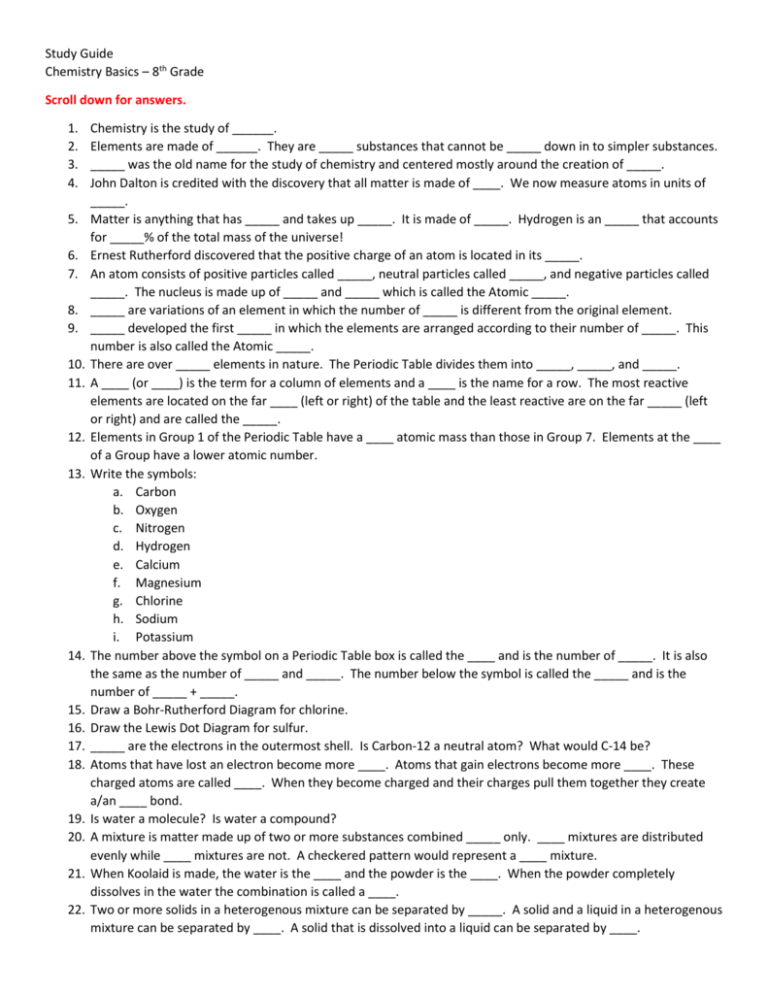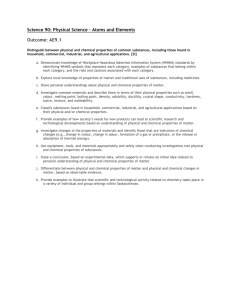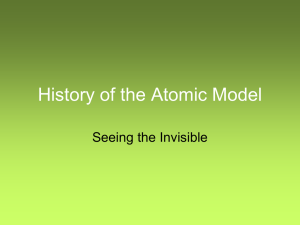Study Guide Chemistry Basics – 8th Grade Scroll down for answers
advertisement

Study Guide Chemistry Basics – 8th Grade Scroll down for answers. 1. 2. 3. 4. 5. 6. 7. 8. 9. 10. 11. 12. 13. 14. 15. 16. 17. 18. 19. 20. 21. 22. Chemistry is the study of ______. Elements are made of ______. They are _____ substances that cannot be _____ down in to simpler substances. _____ was the old name for the study of chemistry and centered mostly around the creation of _____. John Dalton is credited with the discovery that all matter is made of ____. We now measure atoms in units of _____. Matter is anything that has _____ and takes up _____. It is made of _____. Hydrogen is an _____ that accounts for _____% of the total mass of the universe! Ernest Rutherford discovered that the positive charge of an atom is located in its _____. An atom consists of positive particles called _____, neutral particles called _____, and negative particles called _____. The nucleus is made up of _____ and _____ which is called the Atomic _____. _____ are variations of an element in which the number of _____ is different from the original element. _____ developed the first _____ in which the elements are arranged according to their number of _____. This number is also called the Atomic _____. There are over _____ elements in nature. The Periodic Table divides them into _____, _____, and _____. A ____ (or ____) is the term for a column of elements and a ____ is the name for a row. The most reactive elements are located on the far ____ (left or right) of the table and the least reactive are on the far _____ (left or right) and are called the _____. Elements in Group 1 of the Periodic Table have a ____ atomic mass than those in Group 7. Elements at the ____ of a Group have a lower atomic number. Write the symbols: a. Carbon b. Oxygen c. Nitrogen d. Hydrogen e. Calcium f. Magnesium g. Chlorine h. Sodium i. Potassium The number above the symbol on a Periodic Table box is called the ____ and is the number of _____. It is also the same as the number of _____ and _____. The number below the symbol is called the _____ and is the number of _____ + _____. Draw a Bohr-Rutherford Diagram for chlorine. Draw the Lewis Dot Diagram for sulfur. _____ are the electrons in the outermost shell. Is Carbon-12 a neutral atom? What would C-14 be? Atoms that have lost an electron become more ____. Atoms that gain electrons become more ____. These charged atoms are called ____. When they become charged and their charges pull them together they create a/an ____ bond. Is water a molecule? Is water a compound? A mixture is matter made up of two or more substances combined _____ only. ____ mixtures are distributed evenly while ____ mixtures are not. A checkered pattern would represent a ____ mixture. When Koolaid is made, the water is the ____ and the powder is the ____. When the powder completely dissolves in the water the combination is called a ____. Two or more solids in a heterogenous mixture can be separated by _____. A solid and a liquid in a heterogenous mixture can be separated by ____. A solid that is dissolved into a liquid can be separated by ____. 23. ____ changes occur when one substance actually becomes something new. ____ is the ability of a substance to bond with another substance or change into some totally new. ____ is what we call a material that tends to burn. 24. The point at which a liquid becomes gas is called ____. The point at which solid becomes liquid is called ____. The point at which liquid becomes solid is called ____. 25. List 10 physical properties of matter and their definitions. 26. To get the density of a block you would use ____. To get the density of a rock you would use ____. To determine the density of a liquid you would ____. 27. List three states of matter and describe the properties of their shapes and volumes. 28. Density ____ as temperature increases, but motion of particles ____ when temperature increases. 29. List 6 ways to tell if a chemical reaction has occurred. Study Guide with Answers Chemistry Basics – 8th Grade 1. Chemistry is the study of atoms. 2. Elements are made of atoms. They are natural substances that cannot be broken down in to simpler substances. 3. Alchemy was the old name for the study of chemistry and centered mostly around the creation of gold. 4. John Dalton is credited with the discovery that all matter is made of atoms. We now measure atoms in units of nanometers. 5. Matter is anything that has mass and takes up space. It is made of atoms. Hydrogen is an element that accounts for 90% of the total mass of the universe! 6. Ernest Rutherford discovered that the positive charge of an atom is located in its nucleus. 7. An atom consists of positive particles called protons, neutral particles called neutrons, and negative particles called electrons. The nucleus is made up of protons and neutrons which is called the Atomic mass. 8. Isotopes are variations of an element in which the number of neutrons is different from the original element. 9. Mendeleev developed the first periodic table in which the elements are arranged according to their number of ight 10. There are over 100 elements in nature. The Periodic Table divides them into metals, nonmetals and metalloids. 11. A group (or family) is the term for a column of elements and a period is the name for a row. The most reactive elements are located on the far left (left or right) of the table and the least reactive are on the far _____ (left or right) and are called the _____. 12. Elements in Group 1 of the Periodic Table have a lower atomic mass than those in Group 7. Elements at the top of a Group have a lower atomic number. 13. Write the symbols: a. Carbon C b. Oxygen O c. Nitrogen N d. Hydrogen H e. Calcium Ca f. Magnesium Mg g. Chlorine Cl h. Sodium S i. Potassium K 14. The number above the symbol on a Periodic Table box is called the atomic number and is the number of protons. It is also the same as the number of neutrons and electrons. The number below the symbol is called the atomic mass and is the number of protons + neutrons. 15. Draw a Bohr-Rutherford Diagram for chlorine. (See below.) 16. Draw the Lewis Dot Diagram for sulfur. (See below.) 17. Valence electrons are the electrons in the outermost shell. Is Carbon-12 a neutral atom? Yes. What would C-14 be? Isotope of Carbon 18. Atoms that have lost an electron become more positive. Atoms that gain electrons become more negative. These charged atoms are called ions. When they become charged and their charges pull them together they create a/an ionic bond. 19. Is water a molecule? Yes. Is water a compound? Yes. 20. A mixture is matter made up of two or more substances combined physically only. Homogenous mixtures are distributed evenly while heterogenous mixtures are not. A checkered pattern would represent a homogenous mixture. 21. When Koolaid is made, the water is the solvent and the powder is the solute. When the powder completely dissolves in the water the combination is called a solution. 22. Two or more solids in a heterogenous mixture can be separated by sifting. A solid and a liquid in a heterogenous mixture can be separated by filtration. A solid that is dissolved into a liquid can be separated by evaporation. 23. Chemical changes occur when one substance actually becomes something new. Reactivity is the ability of a substance to bond with another substance or change into some totally new. Combustible is what we call a material that tends to burn. 24. The point at which a liquid becomes gas is called boiling point. The point at which solid becomes liquid is called melting point. The point at which liquid becomes solid is called freezing point. 25. List 10 physical properties of matter and their definitions. a. Boiling point (see 24 above) b. Melting point (see 24 above) c. Freezing point (see 24 above) d. Shape (the shape matter takes) e. Odor (the aroma of matter) f. Color (the color of the matter) g. Solubility (the ability of matter to dissolve into another substance.) h. Conductivity (ability of matter to conduct electricity or heat) i. Magnetism (the ability of matter to be pulled to or repelled from a magnetic substance) j. Malleability (the ability of matter to be pounded into sheets) k. Ductility (the ability of matter to be stretched into wire) l. Polarity (having a stronger charge to one side of the molecule) m. Density (mass divided by volume – how densely packed the atoms are in matter) 26. To get the density of a block you would use ruler and balance. To get the density of a rock you would use graduated cylinder and balance. To determine the density of a liquid you would use a graduated cylinder and balance. 27. List three states of matter and describe the properties of their shapes and volumes. a. Solid – holds shape; fixed volume b. Liquid – shape of container; fixed volume c. Gas – shape of container; volume of container 28. Density decreases as temperature increases, but motion of particles increases when temperature increases. 29. List 6 ways to tell if a chemical reaction has occurred. a. Emission of light b. Change in temperature (hot or cold) c. Formation of a precipitate d. Change in color e. Evolution of a gas (bubbles)








